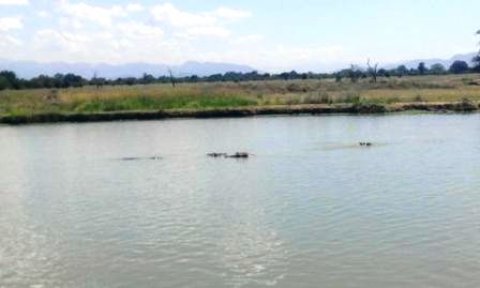 Keta Lagoon Complex
Keta Lagoon Complex
The Keta lagoon is the largest lagoon in Ghana comprising of an open water, surrounding flood plains and mangrove swamps east of the Volta River. It is the most important wetland along the coast of Ghana for waterbirds
| Release date | 04/09/2010 |
|---|---|
| Contributor | Eric Okoree |
 The Keta Lagoon Complex is the largest Ramsar Site in Ghana. The total area designated as the Keta Ramsar Site covers about 53,000 ha and comprises the open water of the Keta Lagoon, the surrounding flood plains and the mangrove swamps east of the Volta River. The lagoon is an extensive brackish water body situated to the east of the Volta River estuary. Although considered to be an open lagoon, it is effectively closed for most of the year. The area of the open water varies with season, but is estimated to be around 30,000 ha, stretching for about 40 km along the coast and is separated from the sea by a narrow coastal ridge.
The Keta Lagoon Complex is the largest Ramsar Site in Ghana. The total area designated as the Keta Ramsar Site covers about 53,000 ha and comprises the open water of the Keta Lagoon, the surrounding flood plains and the mangrove swamps east of the Volta River. The lagoon is an extensive brackish water body situated to the east of the Volta River estuary. Although considered to be an open lagoon, it is effectively closed for most of the year. The area of the open water varies with season, but is estimated to be around 30,000 ha, stretching for about 40 km along the coast and is separated from the sea by a narrow coastal ridge.
Freshwater inflow into the Keta Lagoon is from three main sources: run-off from the Todzie River which enters and fills the Avu lagoon in wet years and overflows into the Keta lagoon via several small tributaries; run-off from Aka and Belikpa streams which enter Keta lagoon directly from the north; and to a limited extent, from the Volta River itself. The lagoon itself is surrounded by numerous settlements and the surrounding flood plain consists of marsh, scrub and farm lands and substantial mangrove stands which are heavily exploited for fuel wood. Occupational activities include lagoon fishing, which is a major source of livelihood for the people, salt winning and crop farming. The coastal villages, particularly Anloga, Woe and Tegbi are famous for their shallots and market gardening, and produces large quantities of onion and okra.
The Keta lagoon is the most important wetland on the Ghana coast for waterbirds and together with Songor Lagoon constitutes the fourth most important waterbirds site on the Gulf of Guinea coast. The site supports 76 waterbird species with an estimated total population of well over 100,000, including globally significant numbers of 21 species. The site is particularly important for waders, supporting almost one third of the estimated East Atlantic Flyway population of Tringa erythropus. Other species which occur in large numbers at the site include Calidris ferruginea, C. minuta, Himantopus himantopus, Dendrocygna viduata, as well as several heron and egret species. The most important parts of the lagoon for waterbirds are the Fiahor, Woe, Tegbi, Adina and Afiadenyigba sections.
Predation of the relatively small numbers of three species of marine turtles, Lepidochelys olivacea, Chelonia mydas and Dermochelys coriacea is very high along the 40km coastline of the lagoon. The catchment is huge, human population density in the area is one of the highest in the country. Land for settlement along the coastal areas is scarce and pollution from domestic waste in some of the villages is a major cause for concern. Sea erosion which previously threatened the existence of the communities along the coast has abated following the completion of the sea defense wall.
